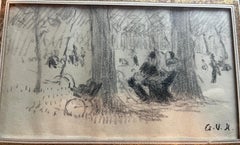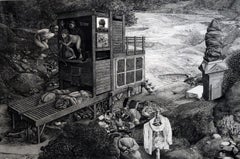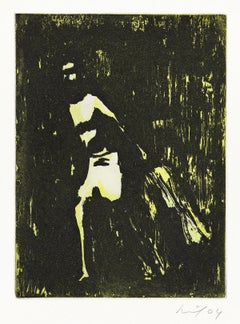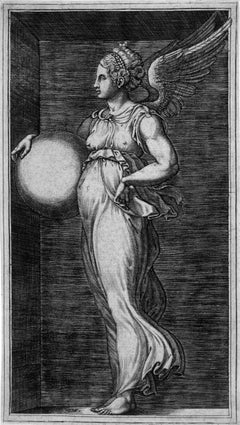Illinois - Figurative Prints
to
2
112
113
63
19
19
Overall Width
to
Overall Height
to
132
38
26
17
8
3
2
2
2
43
34
29
18
14
10
65
238
13
46
76
46
17
2
3
9
9
6
3
2
209
115
2
284
174
109
88
88
83
44
35
35
34
33
32
29
28
21
16
13
13
11
10
172
121
27
20
8
71
1
18,500
17,322
Item Ships From: Illinois
Cirage Jacquot et Cie
By Lucien Lefevre
Located in Greenwich, CT
Cirage Jacquot et Cie is an 1886 chromolithograph of Lucien Lefèvre's delightful poster, printed at Imprimerie Chaix under the direction Ernest Maindron...
Category
Late 19th Century Art Nouveau Illinois - Figurative Prints
Materials
Paper, Lithograph
Gerlach's Allegorien Plate #98: "Poetry" Lithograph by Carl Otto Czeschka
By Carl Otto Czeschka
Located in Chicago, IL
after Carl Otto Czeschka, (1878-1960), Austrian
A leading member of the Vienna Secession and later the Wiener Werkstätte (Viennese Workshop), Carl Otto Czeschka was a vital figu...
Category
1890s Vienna Secession Illinois - Figurative Prints
Materials
Lithograph
Park in Winter (Personnages Dans un Parc)
Located in New York, NY
Black crayon on wove paper. Artist initials are ink stamped in lower right corner.
Category
Early 1900s Post-Impressionist Illinois - Figurative Prints
Materials
Crayon, Laid Paper, Carbon Pencil
Monuments - Highly Detailed Allegorical, Surreal Etching with Multiple Figures
By David Becker
Located in Chicago, IL
"Descriptions I have heard or read of my work, most of which either delight or offend me, are: allegorical, apocalyptic, provocative, prophetic, dream-like, surreal, fantastic, weird, frightening, disturbing, demanding, despairing, disgusting, irrelevant, inspiring, old, new-old, fascinating, morbid, medieval, bizarre, cathartic, mystery-plays (I like that), and well drawn." - David Becker
David Becker
Monuments
etching & engraving
21h x 31w in
53.34h x 78.74w cm
A.P.
DB0022
This etching is matted and framed behind plexiglass. The frame and Plexi may show signs of wear. Contact gallery for detail report.
David Becker
Exhibitions
2017 Coming Attractions, Gallery Victor Armendariz, Chicago, IL
2012 Eye Teeth Group Show, Paint Creek Center for the Arts, Rochester, MI
2011 Art Chicago 2011, Merchandise Mart, Chicago, IL
2010 Art Chicago 2010, Merchandise Mart, Chicago, IL
2009 David Becker Retrospective, Ann Nathan Gallery, Chicago, IL
Art Chicago 2009, Merchandise Mart, Chicago, IL
The 184th Annual Exhibition of Contemporary American Art, National Academy Museum, NYC
Selections, Ann Nathan Gallery, Chicago, IL
2008 Art Chicago 2008, Represented by Ann Nathan Gallery, Merchandise Mart, Chicago, IL
2007 Unruly Muse, Ann Nathan Gallery, Chicago, IL
SOFA NY (Sculptural Objects Functional Art), Ann Nathan Gallery, 7th Regiment Armory, NY, NY
Art Chicago, Merchandise Mart, Ann Nathan Gallery, Chicago, IL
2006 Palm Beach³, Ann Nathan Gallery, Palm Beach, FL
2005 SOFA NY (Sculptural Objects Functional Art), Ann Nathan Gallery, 7th Regiment Armory, NY, NY
Art Chicago in the Park, Butler Field, Ann Nathan Gallery, Chicago, IL
Ann Nathan Gallery, Chicago, IL
Palm Beach³, Ann Nathan Gallery, Palm Beach, FL
2004 Contemporary Prints: National Academy Museum Collection, National Academy of Design, NYC
Art Chicago 2004, Ann Nathan Gallery, Chicago, IL
Fantastic & Visionary Art, touring exhibit: Orange, Manning, Riddoch, & Ballart Gallery, Australia
Return of the Men, Peltz Gallery, Milwaukee, WI
2003 Art Chicago 2003, Ann Nathan Gallery, Chicago, IL
Fantastic & Visionary Art, touring exhibit: Orange Regional Gallery, New South Wales, Australia
National Academy of Design 178th Annual Exhibition, NY, NY
2002 Art Chicago 2002, Ann Nathan Gallery, Chicago, IL
Art of the 20th Century, Ann Nathan Gallery, Park Ave. Armory, NY, NY
Outsider Art Fair, The Puck Building @ Houston & Lafayette Sts., NYC
Self and Other Portraits, Wisconsin Artists, Charles Allis Art Museum, Milwaukee, WI
Return of the Men, Peltz Gallery, Milwaukee, WI
2001 Beyond the 50's, May 4 - July 1, Exhibit A, A Gallery of Art & Design, Birmingham, Michigan
Outsider Art Fair, January 26-28, The Puck Building @ Houston & Lafayette Sts., NYC
"FANTASTIC ART", April/May, Orange Regional Gallery, Orange NSW, Australia.
David Becker: Etchings and Engravings, Ann Nathan Gallery, Chicago, solo exhibition of prints, February.
2000 Four person exhibition, Columbus State University, Columbus, Georgia, Oct. 31 - Nov. 27, 2000.
1999 National Academy 174th Annual Exhibition, NY
University of Wisconsin-Madison Faculty, Elvehjem Museum of Art, Madison, WI
Treasures Revealed: 19th and 20th Century American Works on Paper, National Academy, NY
1995 Bharat Bhavan International Biennial of Prints, Bhopal, India
Contemporary Prints, Selections from John Szoke Gallery, NYC, Drew University, Madison, NJ
Collection Update, 1994, National Academy of Design Museum, NY
1994 David Becker and Robert Sholties, Peconic Gallery, Suffolk Community College, Riverhead, NY
In Black and White: Works by Four Printmakers, Atrium Gallery, University of Connecticut, Storrs
Aesthetics of Athletics: Sports, Games, and Exercise, Charles A. Wustum Musem, Racine, WI
GMI IX Award Winners, Art Center Gallery, Central Missouri State University, Warrensburg
1993 Take Home a Nude benefit auction, NY Academy of Art Graduate School Of Figurative Art, NY
1993 American Prints: Last Half 20th Century, Jane Haslem Gallery, Washingtion, DC
Outstanding American Prints, Anderson Arts Center, Kenosha,WI
National Academy of Design 168th Annual Exhibition, NY
David Becker: Etchings, Davidson Galleries, Seattle, WA
Portraits, Davidson Galleries, Seattle, WA
1992 The Print Fair, 7th Regiment Armory, NY
1991 166th Annual Exhibition, National Academy of Design, NY
Alma College Collection, Detroit Institute of Arts, Detroit, Michigan
Modes of Expression, Potsdam College, SUNY, Potsdam, NY
1990 With Nothing On, Prints and Drawings of the Nude, New Orleans Museum of Art, LA
Prints by Printmakers, Staller Art Center, SUNY-Stonybrook, NY
Publications/Reviews
2007 November 60 Years of North American Prints: 1947-2007, Boston U. Art Gallery, Boston, MA
2003 July 11 Isthmus, Madison, “Welcome to My Nightmare,” by Robert Cozzolino.
2001 March 14 The Wall Street Journal, "Time Off: A Week of Diversions."
Review of Progressive Printmakers (LVM) exhibition.
2001 February Isthmus, Madison, "America's Printland," by Jennifer Smith.
2001 February Capital Times, "The Crowned Prints," by Kevin Lynch.
1999 July Progressive Printmakers: Wisconsin Artists & the Print Renaissance.
1995 – 1999 Who’s Who in America.
1993 Summer The Journal of the Print World, review.
March 14 The New York Times, review.
March 12 The Daily Oklahoman, review.
1990 Dec. 13 The Capital Times, review.
April 28 The Washingtion Post, review.
March 25 The New York Times, review.
Summer The Journal of the Print World, review.
Selected Collections
- additional collections available on requestArkansas Arts Center Foundation, Little Rock, AR
Art Institute of Chicago, Chicago, IL
Brooklyn Museum, NYC
Butler Institute of American Art, Youngstown, OH Detroit Institute of Art, Detroit, MI
Elvehjem Museum of Art, U of Wisconson-Madison
Honolulu Academy of Arts, Honolulu, HI
Library of Congress, Washington, DC
Metropolitan Museum, Miami, FL
Museo de Arte Moderno, Cali, Columbia
National Academy, NY, NY
National Museum of American Art, Washington, DC
New York Public Library, NY
Portland Art Museum, Portland, Oregon
Rose Art Museum, Brandeis University, MA
United States Information Agency, Prague, Czech.
Alberta College of Art, Alberta, Canada
Albion College, Albion, MI
Alma College, Alma, MI
Art Center, South Bend, IN
AT&T Corporate HQ, Plainfield, NJ
Boston Printmakers, Boston, MA
Bradley University, Peoria, IL
Columbia Green Community College, Hudson, NY
Columbus State University, Columbus, GA
Davidson College, Davidson, NC
Dickinson College, Carlisle, PA
Georgia State University – Atlanta
Hope College, Holland, MI
Hunterdon Art Center, Clinton, NJ
Kansas State University, Manhattan, KS
Madison Art Center, Madison, WI
Marui Imai Inc., Sapporo, Japan
Milwaukee Art Center, Milwaukee, WI
Minot Art Association, Minot, ND
North Carolina Print/Drawing Society, Charlotte, NC
North Texas State University – Denton
Ohio University – Athens
Oklahoma Art Center, Oklahoma City, OK
Oklahoma State University, OK
Quad Graphics, Milwaukee, WI
Silvermine Guild of Arts, New Canaan, CT
Springfield College, Springfield, MA
St. Lawrence University, Canton, NY
State University of New York – Fredonia
State University of New York – Potsdam
Trenton State College, Trenton, NJ
University of Arizona Museum of Art, Tucson, AZ
University of Colorado-Boulder
University of Dallas, TX
University of Louisville, Louisville, KN
University of Manitoba, Winnipeg, Canada
University of North Dakota – Grand Forks
University of South Dakota – Vermillion
University of Tennesse – Knoxville
West Chester State College, West Chester, PA
Western Kentucky University – Bowling Green
Private Collections
Carla Leighton, New York, NY
Marc Hauser, Chicago, IL
Michael John Hofer, Chicago, IL
Drs. Mark & Helene Connolly, River Forest, IL
Jamie Kalikow, New York, NY
Dianne & Jim Blanco, Chicago, IL
Denise Roberge, Palm Desert, CA
Tish & Philip Messinger, Creskill, NJ
Brian Wesphal & Michael McVicker, Chicago, IL
Ralph Privoznik, Lafayette, IN
Candice Groot, Evanston, IL
Shomaker/Ruud Collection, Chicago, IL
Braden Berkey and Robert Bartlett, Chicago, IL
Bill and Karyn Silverstein, Highland Park, IL
Steve Weitz, Lovettsville, VA
Mary Allice Wimmer, Madison, WI
Ann & Robert Avery...
Category
1980s Contemporary Illinois - Figurative Prints
Materials
Etching, Engraving
Fisherman
By Peter Doig
Located in New York, NY
A superb impression with vibrant colors.
A superb impression of this color aquatint and etching on Zerkall paper. Edition of 119. Signed and dated in pencil by Doig. Proofed by the a...
Category
Early 2000s Modern Illinois - Figurative Prints
Materials
Color, Etching, Aquatint
Allegorical Figure, Holding a Ball
By Giorgio Mantovano Ghisi
Located in Chicago, IL
Provenance:
Edouard Schultze (Lugt 906)
References:
Bartsch 34
Boorsch & Lewis 38
Notes:
A fine impression of this engraving. Boorsch and Lewis state that this work dates from “the mid-1560s” and suggest that it was after a work by Giulio Romano...
Category
16th Century Old Masters Illinois - Figurative Prints
Materials
Engraving
Flow - Black and White Etching of a Female with Long Hair, Matted and Framed
By Juan Barragán
Located in Chicago, IL
***This artwork is currently on exhibit at the Instituto Cervantes, Chicago until September 2025. If purchased this artwork will be available to ship after September 1, 2025. Contact the gallery with questions.
A woman tilts her head towards the viewer, one eye peaking around the edge of the frame in this small etching by Juan Barragán...
Category
2010s Contemporary Illinois - Figurative Prints
Materials
Archival Ink, Archival Paper, Etching
"Chocolat Carpentier" from "Les Maitres de l'Affiche" series
Located in Hinsdale, IL
GERBAULT, H
(1863-1930)
"Chocolat Carpentier"
Original lithograph from “Les Maitres de L’Affiche” series
Printed by Imprimerie Chaix, Paris
Bearing MDL stamp lower right, from issu...
Category
1890s Art Nouveau Illinois - Figurative Prints
Materials
Lithograph
"Angel More" from Mother of Us All by Robert Indiana
By Robert Indiana
Located in Hinsdale, IL
ROBERT INDIANA
Angel More
(Mother of Us All)
Screenprint in colors on Arches, 1977
Impression 14 of an edition of 150
Image Size: 18” x 14”
Signed, dated, and numbered in lower margin
Printed by Mourlot, Paris.
Intended for publication by Amiel, New York.
Sheehan 96-108.
The Mother of Us All, is an opera which imaginatively chronicles the story of Susan B. Anthony and the women's suffrage movement, written by Gertrude Stein and composed by Virgil Thompson in 1945. In 1976 Robert Indiana was hired to create the costumes and set design for the Santa Fe Opera Company’s production of The Mother to Us All. This collection of lithographs illustrates Indiana's costume designs for the Virgil Thomson-Gertrude Stein same-titled opera.
Robert Indiana is one of the most recognized names in Contemporary and Pop Art, his LOVE sculptures, paintings, and prints are by far his most iconic pieces. It all began in the summer of 1965, when The Museum of Modern Art commissioned Indiana to design its Christmas card. He submits LOVE in four color possibilities; the museum selects the red, blue, and green version. In 1967 he produces three serigraphs of LOVE, and two serigraphs of LOVE Wall. During the next two years, produces other serigraph variations on LOVE, with more following in 1972, 1973, 1975, 1982, and 1991. Indiana’s LOVE motif has since been translated into a US postage stamp...
Category
1970s Art Nouveau Illinois - Figurative Prints
Materials
Screen
"Grande Tuilerie d’Ivry" from Les Maitres de l'Affiche
By Alexandre Charpentier
Located in Hinsdale, IL
CHARPENTIER, ALEX
(1856 -1909)
"Grande Tuilerie d’Ivry"
Original lithograph from "Les Maitres de L'Affiche" series
Printed by Imprimerie Chaix, Paris
Bearing MDL stamp lower right, issue # 33, 1898. Plate #131
Unframed Size: 11 3/8 x 15 3/4”The
"Les Maitres de l'Affiche" series was offered as a subscription series to collectors every month for 60 months, from December 1895 through November 1900. The "Maitres de l'Affiche," were issued as separate numbered sheets, referred to as "plates". They were numbered, with the printers name "Imprimerie Chaix," in the margin at the bottom left hand corner, "PL.1" to "PL.240." In the margin at the bottom right hand corner of each, is a blind embossed stamp from a design of Cheret's. The smaller format and the fact the "Maitres" were a paid subscription series, allowed Imprimerie Chaix to use the latest state of the art printing techniques, not normally used in the large format posters due to cost. A very high quality of paper was used, where as the large format posters were printed on lesser quality newsprint, due to cost and a short expected life span. This explains why the quality of the printing, in the "Maitres de l'Affiche," usually far exceeds that of their larger counterparts. The text reads "Great Tileworks of Ivry, founded in 1854, Ivry-Port near Paris; the largest ceramics factory in the world for building, industry and art productions; Emille Muller stoneware; execution of works by masters of statuary; architectural facings; decorative sculpture; showroom and salesroom, 3 rue Halevy; the only tile able to bear the names Muller and Ivry; (tiles) guaranteed against frost" Given the commission for an extremely text heavy poster, the artist executes a masterful design. The angelic young boy holds the wares of this famous ceramics factory, against an abstract background awash in organic green hues. The handling of the immense text that flows from top to bottom in every available space shows great artistic skill, as the overall beauty of the design is intact. In 1989 the Metropolitan Museum of art acquired a stoneware plaque...
Category
1890s Art Nouveau Illinois - Figurative Prints
Materials
Lithograph
Harpers Magazine "March Hare" Maitres de l'Affiche
By Edward Penfield
Located in Hinsdale, IL
PENFIELD, FERDINAND
(1866 - 1922)
Harper’s Magazine - March
Original lithograph from "Les Maitres de L'Affiche" series
Printed by Imprimerie Chaix, Paris
Bearing MDL stamp lowe...
Category
1890s Art Nouveau Illinois - Figurative Prints
Materials
Lithograph
Fun City, N.Y.C.
By Richard Lindner
Located in New York, NY
A very good impression of this color lithograph. Signed and numbered 125/175 in pencil, lower margin.
Category
1970s Pop Art Illinois - Figurative Prints
Materials
Color, Lithograph
Vintage Chinese Victory Cigarettes Advertisement Poster
Located in Chicago, IL
This 1930s advertisement for Victory Cigarettes melds the meticulous detail of traditional Chinese painting with the craft of color lithography—and a side of risqué. Posters like this one, influenced by the Art Deco movement in the West, recall the economic boom of early 20th century Shanghai, an international center of business and trade. Today, lithograph tobacco posters...
Category
Early 20th Century Art Deco Illinois - Figurative Prints
Materials
Paper, Ink
Vintage Chinese New York Cigarettes Advertisement Poster, c. 1930
Located in Chicago, IL
This 1930s advertisement poster from Shanghai melds the meticulous detail of traditional Chinese painting with the craft of color lithography. Larg...
Category
Early 20th Century Art Deco Illinois - Figurative Prints
Materials
Paper, Ink
"Mascaras de Madres" by Peregrine Honig
By Peregrine Honig
Located in Morton Grove, IL
print portfolio
Category
21st Century and Contemporary Contemporary Illinois - Figurative Prints
Materials
Lithograph, Paper, Screen
Vintage Chinese Gold Bar Cigarettes Advertisement Poster, c. 1930
Located in Chicago, IL
This 1930s advertising poster for the Gold Bar Cigarettes company draws from a well known Chinese opera scene. It melds the meticulous detail of traditional Chinese painting with the craft of color lithography. These advertisements, influenced by the Art Deco movement in the west, recall the economic boom of early 20th century Shanghai, an international center of business and trade. Today, lithograph tobacco posters...
Category
Early 20th Century Art Deco Illinois - Figurative Prints
Materials
Paper, Ink
Untitled by Akio Takamori
By Akio Takamori
Located in Morton Grove, IL
photo xerox with ink
image size - 5 x 6”; frame size - 11 x 12”
BIO
Akio Takamori (1950 - 2017) was a sculptor, printmaker, and painter who explored human relationships: interperso...
Category
Early 2000s Contemporary Illinois - Figurative Prints
Materials
Ink, Laser
"Oeuvre de l'Hospitalite de Nuit" from Les Maitres de l'Affiche
By (Attributed to) Jules Cheret
Located in Hinsdale, IL
CHERET, JULES
(1836 -1932)
"Oeuvre de l'Hospitalite de Nuit"
Original lithograph from "Les Maitres de L'Affiche" series
Printed by Imprimerie Chaix, Paris
Bearing MDL stamp lower ri...
Category
1890s Art Nouveau Illinois - Figurative Prints
Materials
Lithograph
Vintage Chinese Lithograph Advertisement Poster
Located in Chicago, IL
This commercial advertisement poster from 1930s Shanghai melds the meticulous detail of traditional Chinese painting with the craft of color lithography. Large companies often presented posters such as this to their clients to commemorate the Chinese New Year. This poster depicts a young woman luxuriously...
Category
Early 20th Century Art Deco Illinois - Figurative Prints
Materials
Paper, Ink
Art Deco Chinese Pharmacy Advertisement Poster
Located in Chicago, IL
This advertising calendar poster dated from 1920 for the "Chinese and Western Medicine Pharmacy" melds the meticulous detail of traditional Chinese painting with the craft of color lithography. Compared to other Western influenced advertisements of the era featuring seductive women, posters like this one captivated consumers with the latest fashion trends. We see a woman with a Western hair cut...
Category
1920s Art Deco Illinois - Figurative Prints
Materials
Paper, Ink
"The Chap Book " Original lithograph from “Les Maitres de L’Affiche” series
Located in Hinsdale, IL
BRADLEY, WILL
(1868 - 1962)
The Chap Book
Original lithograph from “Les Maitres de L’Affiche” series
Printed by Imprimerie Chaix, Paris
Bearing MDL stamp lower right, from issue #34, 1898. Plate #136
Unframed Size: 11 3/8 x 15 3/4”
The “Les Maitres de l’Affiche” series was offered as a subscription series to collectors every month
for 60 months, from December 1895 through November 1900. The “Maitres de l’Affiche,” were issued
as separate numbered sheets, referred to as “plates”. They were numbered, with the printers name
“Imprimerie Chaix,” in the margin at the bottom left hand corner, “PL.1” to “PL.240.” In the margin at
the bottom right hand corner of each, is a blind embossed stamp from a design of Cheret’s. The smaller
format and the fact the “Maitres” were a paid subscription series, allowed Imprimerie Chaix to use the
latest state of the art printing techniques, not normally used in the large format posters...
Category
1890s Art Nouveau Illinois - Figurative Prints
Materials
Lithograph
"The New Woman" from Les Maitres de l'Affiche by Morrow
Located in Hinsdale, IL
MORROW, ALBERT GEORGE
(1863 -1927)
"The New Woman"
Original lithograph from "Les Maitres de L'Affiche" series
Printed by Imprimerie Chaix, Paris
Bearing MDL stamp lower right, c. 1897. Plate #79
Unframed Size: 11 3/8 x 15 3/4
”The "Les Maitres de l'Affiche" series was offered as a subscription series to collectors every month for 60 months, from December 1895 through November 1900. The "Maitres de l'Affiche," were issued as separate numbered sheets, referred to as "plates". They were numbered, with the printers name "Imprimerie Chaix," in the margin at the bottom left hand corner, "PL.1" to "PL.240." In the margin at the bottom right hand corner of each, is a blind embossed stamp from a design of Cheret's. The smaller format and the fact the "Maitres" were a paid subscription series, allowed Imprimerie Chaix to use the latest state of the art printing techniques, not normally used in the large format posters...
Category
1890s Art Nouveau Illinois - Figurative Prints
Materials
Lithograph
"Femme au Boa" etching by Steinlen
By Théophile Alexandre Steinlen
Located in Hinsdale, IL
STEINLEN, THEOPHILE ALEXANDRE
(1859 -1923)
"Femme au Boa"
Crauzat 61
Etching, Drypoint and Aquatint, c. 1900
Signed in pencil, lower right
From the edition of 13 total impressions
Image Size: 8 5/8” x 5 ½”
The Parisian woman of Paris...
Category
Early 20th Century Art Nouveau Illinois - Figurative Prints
Materials
Etching
Expo 67 Mural--Firepole 33' x 17'
By James Rosenquist
Located in New York, NY
A very good impression of this color lithograph on Italia handmade paper. Signed, titled, dated and numbered 35/41 in pencil by Rosenquist. Printed and published by ULAE, West Islip,...
Category
1960s Pop Art Illinois - Figurative Prints
Materials
Handmade Paper, Color, Lithograph
"Grande Brasserie Van Velsen" from "Les Maitres de L'Affiche" series
By Armand Rassenfosse
Located in Hinsdale, IL
RASSENFOSSE, ARMAND
(1862 – 1934)
"Grande Brasserie Van Velsen"
Original lithograph from “Les Maitres de L’Affiche” series
Printed by Imprimerie Chaix, Paris
Bearing MDL stamp lowe...
Category
1890s Art Nouveau Illinois - Figurative Prints
Materials
Lithograph
"Emilienne d’Alencon" from Les Maitres de l'Affiche
By (Attributed to) Jules Cheret
Located in Hinsdale, IL
CHERET, JULES
(1836 - 1932)
"Emilienne d’Alencon"
Original lithograph from “Les Maitres de L’Affiche” series
Printed by Imprimerie Chaix, Paris
Bearing MDL stamp lower right, from issue #29, 1898. Plate #113
Unframed Size: 11 3/8 x 15 3/4”
The “Les Maitres de l’Affiche” series was offered as a subscription series to...
Category
1890s Illinois - Figurative Prints
Materials
Lithograph





